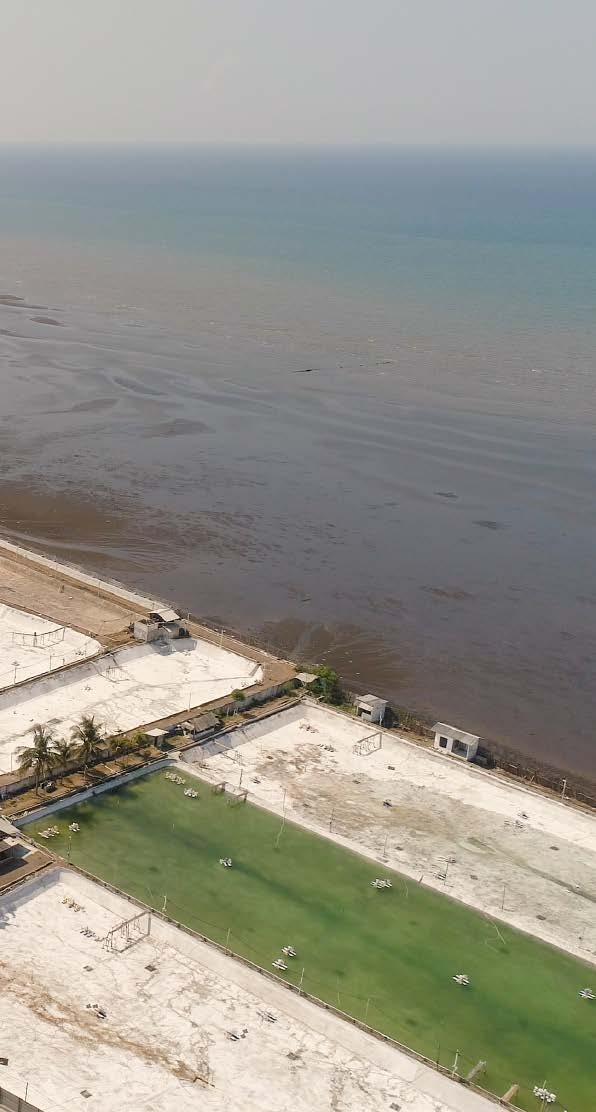
4 minute read
What is the biggest challenge facing shrimp farming today?
While shrimp farming has experienced an overall drop in production, it is less than many pundits believed it would be. When all the numbers are in for 2020, total production may have dropped less than 10% with some areas actually increasing or at least staying close to levels produced in 2019. Despite the rosy picture that many are painting, shrimp farming for the most part, as it is currently practiced in large, is not sustainable.
By: Ph.D Stephen G. Newman*
COVID-19 has had a broadreaching impact on most human endeavors. Interestingly enough, it appears to have actually increased the demand for some types of seafood.
More than likely, this stems from the shift from retail, i.e., the closure and limits placed on restaurants, to home-prepared meals.
Many are discovering that they can prepare tasty and healthy meals with seafood.
Despite the rosy picture that many are painting, shrimp farming, for the most part, as it is currently practiced in large, is not sustainable.
There are several reasons why I have this opinion.
1. Large-scale failure to understand what elements of biosecurity are required for sustainability.
Broodstock are a major source of pathogens entering production systems.
PCR is not suited for the elimination of pathogens from populations that are not also held in a manner that ensures that no pathogens can enter the production system.
Two-way properly designed and run nucleus breeding centers (NBCs) that bring in animals from the field that are not individually held (quarantined), stressed, and screened for all known, not just OIE certifiable pathogens, are not truly biosecure.
NBC's that are one-way (animals leave and new animals never enter) are biosecure.
2. The branding of many animals as SPF and the confusion among farmers as to what this actually means.
SPF stocks can be carrying pathogens and, in many cases, may be.
As soon as an SPF stock leaves the confines of the facility that generated them and are held in non-biosecure conditions, they are at risk.
This is unfortunately quite common in some of the largest producing nations.
Unless each animal is tested individually, the risks remain.

3. Excessive reliance on PCR for screening animals on a population basis.
PCR is a statistical tool that by itself cannot be used to declare that a given population is free of a specific pathogen.
The best one can achieve is a 98% chance of a given pathogen not being present.
This 2% has destroyed many farmers’ crops and will all too easily spread new pathogens.
4. The perpetuation of the myth that shrimp farming is an activity that anybody can engage in.
Globally the vast majority of shrimp farmers are poor and do not have either the resources or the education to understand the nuances involved.
They cannot afford to do things right and are readily victimized by slick salesmen selling them a plethora of solutions that are more snake oil than science.
The continued production of farmed shrimp in this manner ensures that sustainability will remain elusive.
5. Continued environmental degradation.
From the improper construction of ponds and the discharge of raw effluent directly into the same water sources, in many areas, used to fill the ponds in the first place.
Regulating corporations directly or indirectly is much easier than trying to oversee many tens of thousands of individual farmers who, even if they knew what they were required to do, do not have the resources to ensure it.

These are why I see things the way that I do.
Don’t be fooled by those who claim otherwise.
The rush to produce more and more shrimp globally will bring nothing but more disease and more misery to those who break their spirits on the harsh reality that is part and parcel of today’s shrimp farming unless constructive change is brought about.
Small farmers must either band together as coops where they can be forced by either or both the government and the marketplace to ensure that they are engaging in practices that will not spread disease or damage an already seriously damaged environment, or they need to be absorbed into corporate farms or frankly just shut down.
Stephen G. Newman has a bachelor’s degree from the University of Maryland in Conservation and Resource Management (ecology) and a Ph.D. from the University of Miami, in Marine Microbiology. He has over 40 years of experience working within a range of topics and approaches on aquaculture such as water quality, animal health, biosecurity with special focus on shrimp and salmonids. He founded Aquaintech in 1996 and continues to be CEO of this company to the present day. It is heavily focused on providing consulting services around the world on microbial technologies and biosecurity issues. sgnewm@aqua-in-tech.com www.aqua-in-tech.com www.bioremediationaquaculture.com www.sustainablegreenaquaculture.com










